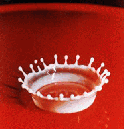OVERVIEW
APPLICATIONS
INTERACTIVE APPLETS
HISTORY OF THE METHODS/FLOW CHART
PUBLICATIONS
EDUCATIONAL MATERIAL
ACKNOWLEDGEMENTS
ABOUT THE AUTHOR/CV
Copyright:
1996-2010
J.A. Sethian
Overview
-
The motion of fluids, and in particular boundaries between fluids, is
exceedingly complex.
For example, there is no computer code in the world (and no one
is even close) that can predict what happens when milk is poured
into a cup of swirling tea. So many things are going on, such
as turbulence in the tea, density
differences between milk and water, and odd shapes of the bowl (and, of
course, don't forget the effect of the spoon), that focusing
on individual effects is enough of a challenge. As a piece of the puzzle,
imagine an air bubble rising in water, a
thermal of hot air rising on a cold day, or smoke rising out of smokestack.
In each case, the interface between the two fluids will change dramatically
as the fluids move.
As an example, consider a bubble of a fluid of one density, initially circular, and rising in a fluid of a heavier density. Although the bubble starts off circular, as it rises it accelerates in the middle, and the sides are caught up in a pair of swirling vortices.



Start Later Even Later Light fluid bubble rising in heavier fluid - How fast the bubble rises, how much swirling goes on at the tips, and how "stable" the boundary is between the two fluids depends on the density differences, the Reynolds number (related to the friction) of the two fluids, and the surface tension between the two, which depends on the curvature of the interface.
-

Movie of Rising Thermal (274K)
Details
-
The calculation was made using a
level set method
to track the motion of the fluid interface. The surface tension is computed
from the local
curvature as given by the level set function, and is manifested as a source
term in the right-hand-side of the Navier-Stokes equations for incompressible
flow. The fluid velocities are computed using Chorin's projection method,
and the level set equation of motion is used to advect the fluid densities.
The density ratio of heavy to light fluid is two to one, and the calculation
is performed on a 512x512 grid.
References
-
-
Projection Methods Coupled to Level Set Interface Techniques
,
Zhu, J., and Sethian, J.A.,
J. Comp. Phys., 102, pp. 128--138, 1992.
OVERVIEW
-
A Coupled Level Set Projection Method Applied to Ink Jet
Simulation,
,
Yu, J-D., Sakai, S., and Sethian, J.A.,
Interfaces and Free Boundaries,
193, No. 1, pp 275-305, 2003,
This paper List of downloadable publications
-
Projection Methods Coupled to Level Set Interface Techniques
,
Zhu, J., and Sethian, J.A.,
J. Comp. Phys., 102, pp. 128--138, 1992.
OVERVIEW
-
Motion of Fluid Interfaces
